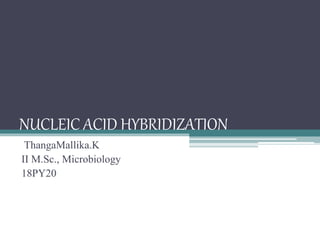
Nucleic acid hybridization
- 1. NUCLEIC ACID HYBRIDIZATION ThangaMallika.K II M.Sc., Microbiology 18PY20
- 2. INTRODUCTION: • A basic technique in molecular biology. in which single stranded Nucleic acids are allowed to interact so that complexes called HYBRIDS are formed by molecules with similar complementary sequences.
- 4. NUCLEIC ACID HYBRIDIZATION: • A technique which has the ability of indivudial single stranded nucleic acid molecules to form double stranded molecules. • The principle of hybridization is the addition of a probe to a complex mixture of target DNA. The mixture is incubated under conditions that promote the formation of hydrogen bonds between complementary strands.
- 6. ABOUT DNA: • Watson and Crick model of DNA was followed and it possess two strands which runs in antiparallel directions and those strands are held by hydrogen bonds. • According to Watson-Crick base pairing, Adenine pairs with Thymine and Guanine pairs with Cytosine by hydrogen bonding. • The mechanism can be achieved by means of Denaturation and Annealing.
- 7. • Since, Nucleic acid hybridization is a process used to identify specific DNA sequences. This is performed by means of DNA probes. • Probes used in hybridization reactions are usually chemically synthesized DNA or RNA that has been labelled with fluorescent dye or radioactive isotope. • Nucleic acid hybridization can be done in all combinations: DNA-RNA, DNA-DNA or RNA-RNA, Insitu Hybridization and FISH analysis.
- 8. FACTORS AFFECTING NUCLEIC ACID HYBRIDIZATION: Strand length Base Composition Chemical Environment.
- 9. HYBRIDIZATION PROBES: • It is a nucleic acid fragment that is complementary to another nucleic acid sequence and thus, when labeled (with radioisotope, fluorescent dye, etc.) can be used to identify complementary segments. • A probe actually hybridizes to single stranded nucleic acid (DNA/RNA) molecules because of complementarity between the probe and target. • Nucleic acid probes can be synthesized in the laboratory, as single and double stranded probes, but a working nucleic acid should be a single stranded only to bind with complementary target (sequence).
- 10. Probes are of three types: o DNA probes: it is a short sequence of DNA labeled isotopically or chemically that is used for the detection of a complementary nucleotide sequences. o RNA probes: it is a short sequence of RNA labeled isotopically or chemically that is used for the detection of a complementary nucleotide sequences. They are also known as riboprobes or complementary probes and are often used in insitu hybridization because of high sensitivity.
- 11. o Oligonucleotide probes: it is a short sequence of nucleotides synthesized to match a region where a mutation is known to occur and then used as a molecular probe to detect the mutation.
- 12. LABELLING OF PROBES: • Hybridization probes can be labelled by two methods: 1. Invivo Labelling 2. Invitro Labelling • INVIVO LABELLING: By supplying labeled nucleotides to the cultured cells. • INVITRO LABELLING: An enzyme is used to incorporate a labeled nucleotide in the probe.
- 13. TYPES OF HYBRIDIZATION: • There are mainly three techniques of hybridization. They are as follows: 1. Southern Hybridization 2. Northern Hybridization 3. Colony Hybridization
- 14. SOUTHERN HYBRIDIZATION: • Southern blot is a techniques employed for detection of a specific DNA sequence in DNA samples that are complementary to a given RNA or DNA sequence. • It was first given by E.M Southern, a British biologist. This methods includes separation of restricted DNA fragments by electrophorosis and then transferred to a nitrocellulose or a nylon membrane, followed by detection of the fragment using probe hybridization.
- 16. APPLICATIONS: • Southern blots are used in gene discovery, mapping, evolution and development studies. • To identify specific DNA in the sample. • To isolate desired DNA for construction of DNA. • Used in phylogenic analysis. • Used to make RFLP maps.
- 17. NORTHERN HYBRIDIZATION: • Northern blotting was developed by James Alwine, George stark and David Kemp (1977). In this technique, RNA is being analysed instead of DNA. • It is a technique by which RNA fragments are separated by electrophorosis and immobilized on a membrane. The identification of specific RNA is done by using nucleic acid probes. It helps to study gene expression by detection of RNA.
- 19. APPLICATIONS: • To study the gene expression of various tissues, organs, development stages, pathogen infections. • mRNA splicing studies. • Identification of transferred genes in transgenic individuals.
- 20. COLONY HYBRIDIZATION: • It is a rapid method of isolating a colony containing a plasmid harboring a particular sequence or a gene from a mixed population. • The colonies to be screened are first replica plated onto a nitrocellulose filter disc that has been placed on the surface of an agar plate prior to inoculation.
- 22. In situ Hybridization: • It is a technique that employs a labeled complementary nucleotide strand for localizing specific DNA or RNA sequence targets within fixed tissues and cells. There are two ways to detect DNA or RNA targets: i) Chromogenic insitu hybridization ii) Flourescence insitu hybridization.
- 23. CISH FISH
- 24. APPLICATIONS: • Library screening • Southern blot • Northern blot • ASOs ( Allele-specific oligonucleotides ) to detect mutations.